The Nreal Air glasses are among the smartest glasses you'll find in 2022, providing a transparent 130in display for games and movies, but the USB-C cable will likely put off some.
Should I Buy The Nreal Air?
Pros
- Compact, lightweight form factor
- Detailed, bright semi-transparent displays
- Air Casting mode has endless uses
Cons
- MR Space functionality is limited
- Connects to smartphones via USB-C
- Limited smartphone compatibility
Our Verdict
Price When Reviewed
- $599
Smart glasses are set to be the next big thing in wearable tech. It’s appearing in all shapes and sizes, from Meta’s camera-equipped Ray-Ban Stories to the audio-focused Soundcore Frames and HTC’s VR-esque Vive Flow.
The latest to appear on the market is the Nreal Air, an entertainment-focused pair of smart glasses that provides access to a large transparent 130in display in a surprisingly lightweight form factor.
The question is, is the tech ready for the prime time or should you wait for the inevitable second-gen device in a few years’ time? I’ve spent some time with Nreal’s latest AR smart glasses, and here’s what I think.
Design & build
- Lightweight, portable design
- Balanced weight
- Comfortable for shorter periods of use, but can get uncomfortable over longer periods of wear
The Nreal Air is one of a growing number of smart glasses that look like regular sunglasses – and considering the tech on offer, that’s no easy feat.
In fact, at a glance, you might not be able to tell that they’re smart glasses at all. Unlike the likes of the HTC Vive Flow, the design of the Nreal Air is- very discreet, with a largely black plastic build with flashes of silver aluminium that add to the premium look on offer.
Instead, the glasses simply sit on your face just as a normal pair of sunglasses would – an impressive achievement from the Nreal team. There are three sets of nose bridges in the box, and angled arms also help to get the perfect fit for your face.
With a largely discreet design, the only giveaway that they’re smart are the lenses themselves, with small mounted transparent displays on each lens that glint when active for a Cyberpunk-esque effect. That, and a cable running from the back of the left arm, of course – but more on that in a minute.
If you’re in a particularly bright room and struggling to see the transparent displays, there are tiny buttons on the underside of the right arm that controls the brightness and power of the display, allowing you to quickly crank up the brightness.
Volume, on the other hand, is controlled exclusively by your connected smartphone and delivered by small down-firing speakers on each arm. The quality is surprisingly good, and I used the glasses speakers when watching movies on Netflix and gaming without complaint, though it is audible to those nearby.
When not donned on your face, the Nreal Air glasses live in a microfiber-lined hard carry case that’ll protect them from drops and light impacts, with a handy compartment for the aforementioned cable and a cleaning cloth to keep the lenses spick and span.
There’s also a soft carry case in the box, but I’m not sure I’d trust myself with such a pair of expensive glasses in a soft case.
A Smartphone-Powered Experience
- Needs a smartphone for power and smarts
- Can't connect a powerbank and use wirelessly like Vive Flow
- So, about that cable.
The reason why the glasses are so lightweight and comfortable to wear over long periods is that there isn’t very much onboard processing power. Instead, the glasses require both power and smarts from a connected smartphone – and that’s where the (detachable) USB-C cable comes into play.
It’s not a new concept, of course. Other headsets, like the Vive Flow, also require a smartphone for power and smarts – though HTC’s implementation is smarter. Unlike the Nreal Air, you can use a powerbank to power the Vive Flow and use a smartphone as a controller wirelessly.
It does add more bulk to the setup, but it also means you aren’t draining your smartphone battery as quickly.
To complicate things further, the Nreal Air glasses aren’t compatible with all smartphones. It needs a USB-C port, which makes it incompatible with iPhones and cheaper Android smartphones, and even then, only certain smartphones seem to be able to run the experience well.
I was provided with an Oppo Find X5 for review purposes, and Nreal has a list of recommended smartphones compatible with the Nreal Air glasses, but it’s something to be aware of.
While some might instantly dismiss a hardwired connection to a smartphone, there are benefits. For one, you’ll never have to charge the headset separately and risk it being dead when you want to use it, and you’ll also have access to all the apps on your smartphone without needing to redownload and set anything up.
Of course, it would be nice to have a truly wireless experience, but the tech just isn’t there yet. It’s a good first step, and it’ll be interesting to see how it develops over the next few years.
- The MR Space is visually appealing, but limited in functionality
- Air Casting mode is great, but basic in its implementation
- Great for watching movies and playing cloud games
The key difference between the Nreal Air and the likes of the Vive Flow is the display tech on offer; while the Vive Flow offers a VR-esque experience with a completely blacked-out display, the OLED displays within the Nreal Air frames are semi-transparent, allowing you to see the world around you.
The transparent nature of the displays provides an interesting mixed reality effect like that from Hollywood blockbusters, with virtual windows overlayed onto the physical environment.
It’s worth pointing out that these elements can’t interact with the environment like AR apps for the Quest 2 and HoloLens 2 due to the lack of front-facing cameras needed to track its position, but they’ll stay locked in place as you turn on the spot.
Regardless, the mixed reality effect is undoubtedly impressive, and you’ll likely be just as impressed as I was the first time I donned the glasses and booted up the MR Space, one of two modes available on the Nreal Air.
The MR Space is undoubtedly the more visually impressive of the two modes available, displaying a transparent mixed reality interface with access to basic apps, webpages and other functions. Without a dedicated controller, your smartphone doubles up as a virtual pointer, allowing you to interact with the interface rather intuitively.
There’s access to a very limited number of apps in this mode, including one that plays videos of bike rides to ‘trick’ your brain when on an exercise bike, though it doesn’t actually connect to any exercise bikes to adjust speed depending on your speed. Still, I found myself getting into a ride more than I usually would on the exercise bike demo at the UK launch event.
The main draw of the MR Space is the ability to access websites and web-based apps using its built-in browser.
It allows you to open multiple windows – be it sites like Twitter or web-based players like YouTube or BBC iPlayer – side-by-side, with the ability to move, resize and even adjust the distance between you and the virtual window, adding extra depth to the mixed reality experience on offer.
It really does feel cool picking up a window, shrinking it down and moving it around the room around you.
There could be work-focused applications to this mode if there were a way to mirror your smartphone or PC display within the MR Space, but right now, that’s limited to the second mode of the glasses – Air Casting.
As the name suggests, Air Casting mirrors your connected smartphone to a virtual 130in display that appears roughly 4m in front of your eyes. It is a little misleading though, considering you have to physically connect the glasses to a smartphone to use the mode. Not very ‘air’ like, right?
Iffy branding aside, it’s much more limited in functionality than the fully-fledged MR Space, with no UI and no way to move or adjust the window size. Rather disappointingly, it doesn’t even offer the same 3DoF tracking as the MR Space, with the fixed display moving, shaking and rotating as you move your head.
Despite all that, it’s the mode that I imagine users will enjoy the most, for the simple reason that they can enjoy all the apps and games on their smartphones on a huge display.
It’s far from just being able to browse the likes of Instagram and Facebook on the big screen though. The experience lends itself more to entertainment-focused apps like Netflix, YouTube and BT Sport, providing a more cinema-esque way to enjoy your content be it at home, on the bus or on a plane.
For me, though, the main use was gaming. Connected to an Xbox controller via Bluetooth, I was able to stream games from the likes of Xbox Game Pass and Stadia, delivering a PC-level gameplay experience to a lightweight pair of glasses practically anywhere with good enough internet connectivity.
You’ve also got the option of slipping on a hard glasses cover (provided in the box) that’ll completely black out the displays for a more traditional VR-esque experience, though without a faceplate to block your peripheral vision, there’s a limit to just how immersive the experience can be.
I quite like the fact I’m still aware of the world around me, allowing me to keep an eye on things as I play games and watch TV, but I’ll concede it’s not as immersive as a VR headset or the HTC Vive Flow.
The glasses will display the screen of many USB-C enabled devices when plugged in, including some laptops (though funnily not the MacBook Pro in testing) and even USB-C enabled iPads, which could potentially allow the glasses to be used in small spaces for work.
Don’t try to use it with an iPhone though; even with a USB-C to Lightning cable, the inability of Apple’s Lightning port to provide power and data simultaneously means it won’t work.
Still, it’s a handy tip that’ll be helpful for some.
Price
The Nreal Air glasses aren’t the cheapest around, coming in at a cool £399/$599. That is £100 cheaper than HTC’s Vive Flow headset in the UK, however, its $499 US price tag makes it cheaper than the Nreal specs in the States.
If you are tempted, it’s available exclusively via EE in the UK, with the network offering either an upfront cost or the ability for existing customers to split the price across 11 months at £35 a month.
As in the UK, the Nreal Air glasses are a Verizon exclusive in the US, making it the only place you’ll be able to buy them in the States.
Verdict
The Nreal Air glasses are undoubtedly some of the most impressive smart glasses around, providing a mixed reality experience in an impressively lightweight and compact form factor. Of course, the caveat is that you’ll need to connect your smartphone for both power and smarts, but that’s true of most smart glasses available in 2022.
The MR Space is visually impressive, allowing for a Hollywood-esque mixed reality experience where you can place, move and resize windows in your semi-virtual environment, but the lack of dedicated apps means it’s more of a proof of concept than something users will use regularly.
The Air Casting mode is the real treat, allowing you to access apps like Netflix and Xbox Game Pass from a connected smartphone on a large 130in display, though I would’ve liked a little more polish than a simple fixed display.
The Nreal Air glasses aren’t quite the smart glasses of tomorrow then, but they paint a very exciting picture for the smart glasses market in the next few years.
And, with all that said, they’re still very fun to use.
Specs
- 79g
- 148mm x 52mm x 159mm (opened)
- 148mm x 52mm x 60mm (folded)
- Head width: 120-186mm
- Display: Full HD (3480 x 1080) OLED panels
- Compatible with select Android smartphones
- 2 Operating modes



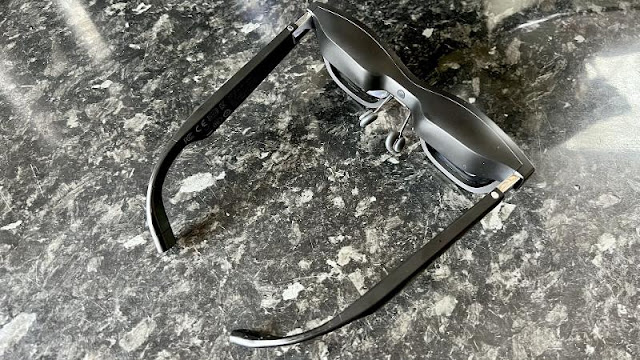




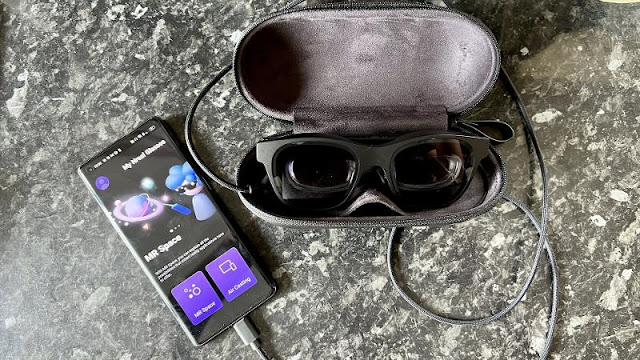
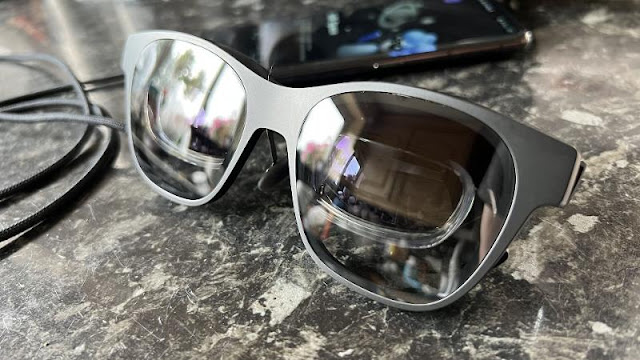
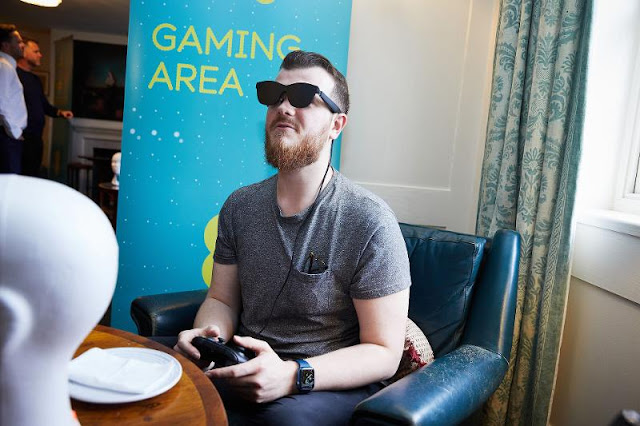
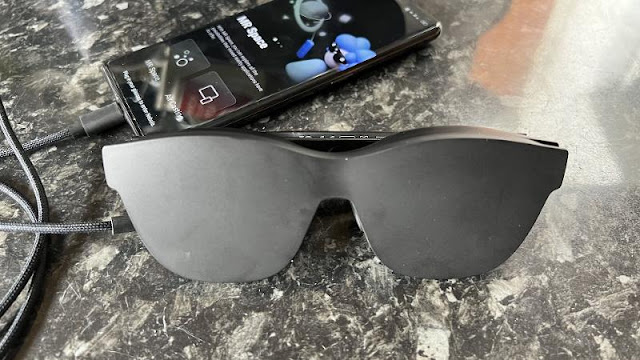

0 comments:
Post a Comment